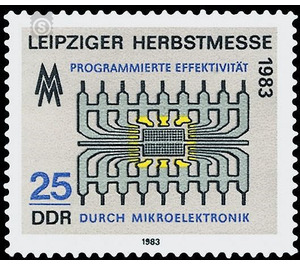Commemorative stamp series - Germany / German Democratic Republic 1983 - 25 Pfennig
Theme: Calender
| Country | Germany / German Democratic Republic |
| Issue Date | 1983 |
| Face Value | 25.00 |
| Color | violet |
| Perforation | K 14 |
| Printing Type | Rotogravure 2 |
| Stamp Type | Postage stamp |
| Item Type | Stamp |
| Chronological Issue Number | 2565 |
| Chronological Chapter | GER-DDR |
| SID | 975538 |
| In 19 Wishlists | |
Leipziger Herbstmesse 1983 At the Leipzig Autumn Fair 1983, the Ministry of Posts and Telecommunications of the German Democratic Republic publishes two multicolored special postage stamps. Special cancellation from August 30 to October 29, 1983 25-pfennig value: Programmed Effectiveness through Microelectronics Since the discovery of the bipolar transistor, a semiconductor-based electronic amplifier element, in 1947, a stormy development has taken place internationally the DDR a powerful semiconductor industry was built. Today, thanks to high-precision photolithographic equipment being developed and produced in our country, it is possible to use several tens to hundreds of thousands of these amplifier elements instead of one transistor on a semiconductor wafer of about 25 square millimeters and a thickness of about 0.1 mm so-called chip - in the form of an electronic circuit - to produce the integrated circuit. Extreme technical demands are to fill the metallurgy, glass and ceramics industry and others in terms of purity and precision, in addition to the aforementioned equipment construction by chemistry. Thus, in a cubic meter of solvent or air often only a few impurities or dust particles may be allowed. The enormous expense of building microelectronics has been greatly recovered by the economic effects of the widespread use of microprocessors, memory circuits, counting and logic circuits, television and radio circuits, and many others from VEB Kombinat Mikroelektronik. By eliminating 70 to 90 percent of mechanical parts in the production of new products, such as B. the electronic typewriter S 6011 from VEB Kombinat Robotron, the quartz watches caliber 15-11 from VEB Kombinat Mikroelektronik, the electronic teletype recorder F 1100 from VEB Kombinat Nachrichtenelektronik u. a. Material and working time are saved considerably. The use of electronic controls for machine tools, chemical plants, rolling mills, cement plants, sewing machines, medical equipment and many other applications leads to a huge increase in labor productivity for the benefit of each one. For years, the number of produced circuits has exceeded the number of the population of our country many times over. We must remember that the widespread use of microelectronics worldwide is still in its infancy. Other significant milestones in this way will be the control of facilities and machines including those for domestic use, such as typewriters or televisions through human speech, or the widespread adoption of flexible processing centers based on freely programmable, microcomputer controlled robots, resulting in fundamentally new quality production of products. The building block of all this will continue to be integrated circuits, for the further development and mass production of which all necessary preconditions have been created in our country and will be further expanded to the required extent in accordance with the goals of our society and to our mutual benefit.


